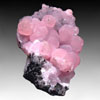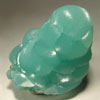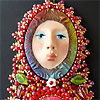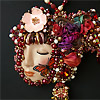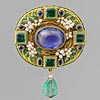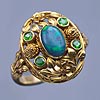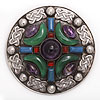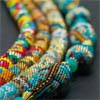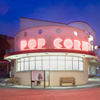January, 2016

Happy birthday, MyLovelyBeads.com!Time is flying, and MyLovelyBeads.com is already 9 years... It's hard to believe, isn't it? Celebrate our anniversary and stay with us, we've got a lot more to say! Read in the January issue of our newsletter:
Smithsonite - mineral ore of zinc
Contact us with any questions at
info@mylovelybeads.com.
Fashion Colorworks. Sponsor - OktaBeads.eu Designing "shibori ladies" - Ewa Machnik Arts and Crafts movement Beaders Best Bead Art Fair 2016 February upcoming events Best regards, MyLovelyBeads.com Team
|
Smithsonite - mineral ore of zincSmithsonite is a mineral ore of zinc, it belongs to the calcite group of minerals. Smithsonite is translucent in clarity, with glassy or pearly luster, it mostly occurs as blue (sometimes mistakenly is called "azurite"), green (apple-green to dark variety is called "herrerite") and pink stones. Beside these colors smithsonite is also found yellow, yellow-green, orange-yellow, pink, purple, gray, brown, white, and colorless or faintly tinted in transmitted light. The original name for the mineral of smithsonite was "calamine" but James Smithson (1754-1829), British chemist, mineralogist, and benefactor of the Smithsonian Institution (Washington, DC, USA) distinguished that "calamine" was in fact three different minerals: hemimorphite, hydrozincite, and the zinc carbonate. So, the actual smithsonite was given that name in 1832 by Francois Sulpice Beudant in honor of James Smithson. The other name for smithsonite are "Aztec Stone" (which is also a name for the green variety of turquoise), "Bonamite" (blue to green smithsonite and also a name for smithsonite in the gem trade), "Turkey-Fat Ore" - which is the old name for the bright yellow variety, and "Dry Bone Ore" - that describes the massive, porous, and dull variety. Smithsonite is relatively soft for jewelry, though it's sometimes polished and used as an ornamental stone. Smithsonite rarely occurs in visible crystals. The only two locations to produce large crystals of significance are Tsumeb, Namibia, and Broken Hill, Zambia. Many of the rounded forms have a feathery or sparkling light effect. Large crusts are found in Italy, Greece, Spain, Kazakhstan, Germany, Poland, and Russia. Mexico has two outstanding localities, which contain beautifully colored smithsonite, including deep pink and electric green colors. The US has many fine occurrences in the states of New Mexico, Arizona, Arkansas, Colorado, California, Utah and Wisconsin. |
|
Fashion Colorworks. Sponsor - OktaBeads.eu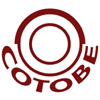
At the end of 2012, when the Fashion Colorworks 2013 was announced, many people noticed that we had two more prizes: "Best in Contest Winner" and "Best in Contest Runner-up." Since then, the Czech company OktaBeads.eu has constantly sponsored our contest, and the Fashion Colorworks 2013 is not an exception. OktaBeads.eu has been on the market of products for crafts since 2009, its main specialization is beads. The company director, Grigory Zevaev, said of its concept: "Working with four largest global manufacturers of beads, we realized that there are no bad beads - there are only beads that are better to work a particular project, from this we proceed in the selection of our products stock." Beads presented in OktaBeads.eu shop can be divided into Japanese and Czech groups. Japanese beads have primarily a large hole, which allows multiple needle passes through each bead while Czech beads have a very big range of colors and rich range of coatings. Grigory says, "One day, we thought, why not to combine all of the best that is in each of these two types of beads in one product? As a basis we took the quality Japanese beads with a large hole and added the traditional Czech art color processing and coating. This is how COTOBE beads appeared (the name is an abbreviation of the expression "COlor TO BEads") - beads, which has a non-standard color, large hole, high quality and uniform shape." Using COTOBE beads expands the boundaries of creativity and imposes no restrictions on techniques. Two-color bead series "Gold Collection", "Mystic Collection", "Sunshine Collection", "Silver Collection" and "Metallic Collection" are unique; they provide exquisite color patterns by using even single type of beads. It does not matter whether there are two or three rows of bead weaving, rope or embroidery. The series "Antique Collection" and "Antique Nobilis Collection" perfectly suited to work in free-form technique and working with gemstones. Now 39 colors are already available, the size of the beads is basically 11/0, but there are 8/0, too. The company is planning some more colors and the sizes range will also be expanded. OktaBeads.eu fully controls the production process and is constantly optimizing it, which allows not increasing the cost of the beads in terms of increasing production expenses while maintaining high quality. Wholesales are also possible; the conditions of them are specified in each individual case. Try COTOBE and enjoy its beauty and other advantages in a variety of beaded crafts!
Website of OktaBeads.eu
|
|
Designing "shibori ladies"Ewa Machnik was born in Poland and now she lives in France. She is a very happy mother of three children, an organic chemist with PhD degree and a beader with many beading ideas. Her favorite technique is bead embroidery but she loves using different ones in her projects. Meet Ewa and enjoy her story and bead art! Ewa says, "I started beading and making jewelry as a hobby four years ago and I'm still fascinated by all kinds of embroidery as a child; it became my real passion. As a kid, I watched my mother and grandmother creating beautiful embroidered pieces. I grew up in a Slavic family where the art of embroidery was passed from generation to generation. I love bead embroidery and I try to put in it as much of my imagination as it's possible. I love to hide small details amongst different kinds of the beads, stones and crystals. I always like using many different techniques and materials. My favorite colors are warm ones; in my beadworks the most often you can see the shades of brown, golden (gold iris is my favorite), red and from time to time purple and blue. Mostly, it depends on my mood which color I implement in my work. My favorite beads are definitely the teardrops. I use them very often and their different sizes allow me to reach desired texture in the project. I love using all kinds of crystals. Certainly, they provide shine, brightness and joyful radiance to any item and I feel happy. I like the new Piggy and O-beads, which give me ability to create beautiful flowers and to change the texture of a jewelry piece. I make very fancy necklaces and sometimes very modern pieces. My beading style is very romantic and my designs are full of happiness and surprises waiting for those who would like to explore my jewelry more carefully finding and watching many small details hidden amongst beads, stones, crystals and other elements. I am sure this expresses my childish happiness, which I try to keep inside of me. Mostly, I find my inspiration in the nature all around me. I love watching colorful animals and beautiful gardens full of amazing flowers or just a few rays of sun passing through autumn leaves which children and romantic ladies want to catch during their walk in the forest. Many things boost my creative energy..."
Full article by Ewa Machnik
|
|
Arts and Crafts movementThe Arts and Crafts movement (not style!) was an international movement in the decorative and fine arts that flourished in Europe and North America between 1880 and 1910, emerging in Japan in the 1920s. It stood for traditional craftsmanship using simple forms, and often used medieval, romantic or folk styles of decoration. Essentially, it was anti-industrial and advocated economic and social reform. The guild revival movement breathed new life into the business of designing and making jewelry. Its influence was felt in Europe until it was displaced by Modernism in the 1930s, and continued to be popular among craft makers and designers long afterwards and even now. The Arts and Crafts movement emerged and developed as a reaction to the Industrial Revolution against contemporary styles that the reformers associated with machine-production, partly a reaction against the style of many of the items shown in the Great Exhibition of 1851. Manufactured goods were artificial, often ornate but poorly designed, using inferior materials and produced by abused factory workers. So, many artists including jewelry designers rebelled against that, returning to intricate designs and individual handmade craftsmanship as a way to provide art and beauty into every home. It was common for jewelry of this era to be simple in pattern and made of colorful, uncut stones and very often in cabochon cut. Arguably, the other main aim of the Craft Revival was to bring the pleasure of original creative activity into the lives of the men and women of the working classes, and to relieve the monotony of the repetitive mechanical labor for the greater part of their working hours. Advocates like William Morris, Owen Jones and John Ruskin were relentless in their push toward a medieval style to produce items used in everyday life. Gothic and Renaissance revival movements in jewelry turned to the past for pleasing shapes and motifs. A back to nature styling, which relied heavily on floral and foliate motifs along with insects, shells and other objects from nature emerged like a breath of fresh air... |
|
Beaders Best Bead Art Fair 2016Bead Art Crossover: beginning 2016 year, BEADERS BEST Art Fair supported by Perlen Poesie magazine that has taken place for many years in Hamburg, Germany is joining "Mineralien, Fossilien, Schmuck" ("Minerals, Fossils, Jewelry") and "Kreativ" ("Creativity") shows at the Messe Stuttgart. A complete selection of components for all forms of jewelry making will be under one roof now! Exhibitors offer high quality glass beads, crystals, handmade beads, cabochons, gemstones, silk, jewelry wire, clasps and much more - all that a jewelry lover's heart could desire! Demonstrations and workshops are held at various booths. Jewelry projects and material kits are also available. As usual, the live jewelry fashion show and exhibition of jewelry designs will bring an air of sophistication to the fair. The event will take place from April 1 to 3, 2016.
Subscribe to Perlen Poesie magazine
|
|
Upcoming eventsCreative Crafts Council: On Tour
January 16 - February 21, 2016 The Glen Echo Park Partnership hosts Creative Crafts Council: On Tour. This exhibition features artists whose work had received awards at the Creative Crafts Council 30th Biennial Exhibition, which originally took place at Strathmore Mansion in June-July 2015. Handmade: Explorations in Fiber Art
February 4-27, 2016 Handmade: Explorations in Fiber Art is a juried exhibition of contemporary works of fiber art employing traditional and non-traditional materials that are woven or stitched using textile techniques which include weaving, quilting, embroidery, beading, felting, crochet, knitting, lacework, hooking, sewing, spinning, tapestry, and mixed media along with current innovations in this evolving medium. |
|
Note
If you don't see the newsletter properly formatted please click here:
January Issue
|
© 2016 MyLovelyBeads.com All Rights Reserved.
If you do not want receive our newsletter and you wish to remove your email address from our mailing list, please click the following link to unsubscribe.



